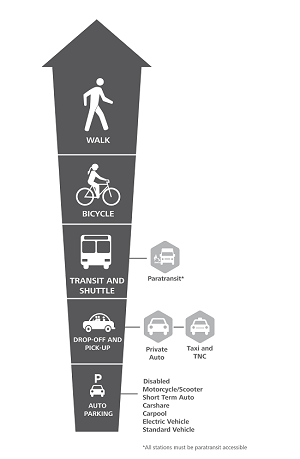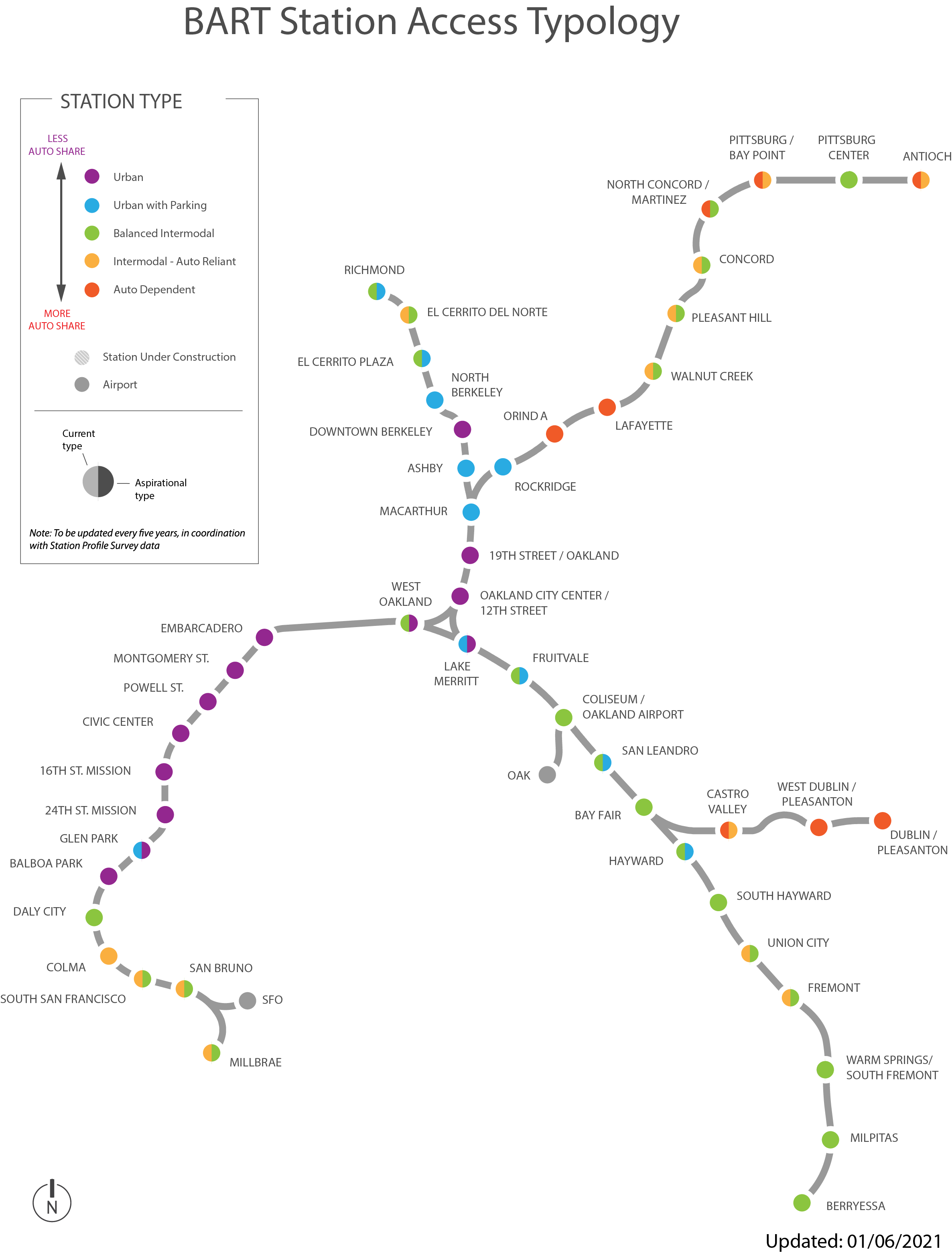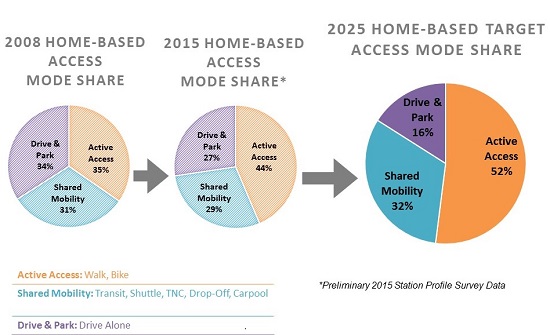BART Station Access Policy
In June 2016, the BART Board adopted a new Station Access Policy (PDF) to guide access practices and investments through 2025. The Policy identifies the following goals and Strategies:
Goals
Safer, Healthier, Greener.
Advance the region’s safety, public health, and greenhouse gas (GHG) and pollution-reduction goals.
More Riders.
Invest in station access to connect more riders cost effectively, especially where and when BART has available capacity.
More Productive and Efficient.
Manage access investments, programs, and current assets to achieve goals at the least cost.
Better Experience.
Be a better neighbor, and strive for an excellent customer experience, including on the first and last mile of the trip to and from BART stations.
Equitable Services.
Invest in access choices for all riders, particularly those with the fewest choices.
Innovation and Partnerships.
Be an innovation leader, and establish durable partnerships with municipalities, access providers, and technology companies.
Strategies
- Plan, Innovate and Partner
- Plan for systemwide access mode shift to reduce drive alone rates
- Partner with interested stakeholders to improve access to the BART system
- Plan all BART facilities to be accessible to all users
- Invest and Implement
- Invest in the pedestrian and bicycle network, on and off BART property
- Invest in transit connections
- Prioritize station access investments that support reverse peak travel
- Invest in strategic parking resources
- Manage and Assess
- Manage existing assets
- Regularly collect station access data

The Station Access Design Hierarchy helps guide design decisions at the project level.

Access investment priorities at each station are guided by the station's assigned access type.
Performance Measures
Following the Policy adoption, the BART Board adopted Performance Measures (PDF) with targets to help evaluate how BART is doing in implementing the Station Access Policy. A key Performance Measure is the home-based access mode share target, which seeks to increase active access (access by walking and bicycling) from 44% to 52%.

Background
To inform development of the new policy, BART prepared the BART Access Policy Update (PDF) background report that identifies the current policy context, discusses recent trends, and examines selected best practices from other transit agencies. This report and a BART Presentation on Station Access (PDF) were discussed at a Board workshop in October 2015. In early 2016, the BART Board discussed a more detailed presentation of the draft policy and supporting documentation; these materials were refined to reflect the Draft Policy above.
Previous BART Access Policies and Practices
- 2000 BART Access Management and Improvements Policy - superseded (PDF)
- 2003 Station Access Guidelines (PDF)
- 2005 Access Policy Methodology (PDF)
- 2006 Access BART Study (PDF)
- 2008 Station Profile Study (PDF)
- 2011 BART Taxi Rules (PDF)
- 2014 Pittsburg/Bay Point Line Access Study (PDF)
- 2015 Bike Parking Capital Program (PDF)
- 2015 relevant BART Board adopted policies (PDF)
- 2018 North Concord to Antioch BART Access Study
Peer Agency Best Practices
- TCRP Guidelines for Providing Access to Public Transportation Stations (PDF): National guidelines on how to best provide access to stations.
- LA Metro Parking Management Work Program (PDF): This presentation outlines for Metro's board the activities that the agency is undertaking to address parking. It describes how Metro now has a project underway to update the agency’s parking policies and develop a comprehensive Supportive Transit Parking Program (STPP) Master Plan.
- TransLink Park-and-Ride Policy (PDF): This document states TransLink's approach to managing parking. While it applies to the region’s entire parking system, TransLink has taken steps to implement parking management at transit stations through the adoption of its parking pricing program in 2012. This policy is similar in many respects to BART’s parking pricing strategy.
- Tri-Met Pedestrian Network Analysis Project (PDF): A detailed, system-wide assessment of pedestrian conditions on and off station property in the Tri-Met system. BART is using this as an example, and plans to include a pedestrian network analysis at ten BART station areas.
- WMATA Bicycle and Pedestrian Access Improvements Study (PDF): This study put in motion a campaign to enhance bicycle and pedestrian access to WMATA stations. It set a goal of tripling bicycle access mode share by 2020, and set the foundation for a capital plan to steer non-motorized access improvements throughout the system.
- WMATA Station Site and Access Planning Manual (PDF): In 2008, WMATA developed the Station Site and Access Planning Manual. In it, the agency developed mode prioritization strategies and guidelines to guide planning and design at a range of station types.
If you have questions or comments on the Policy, please send them to [email protected]